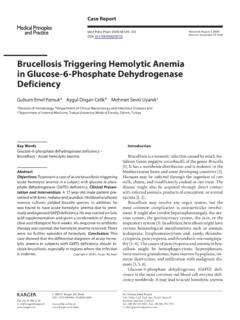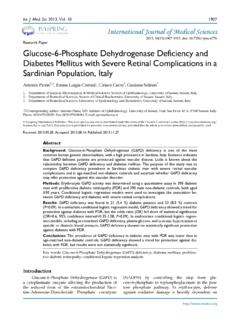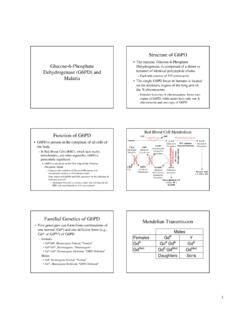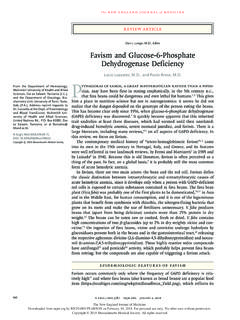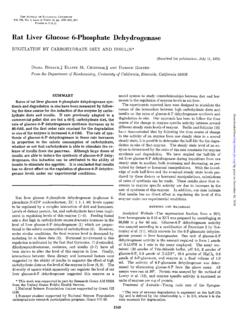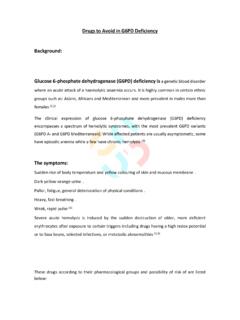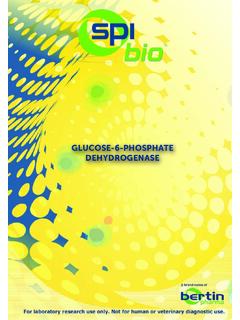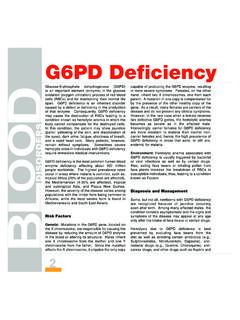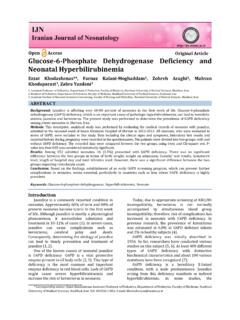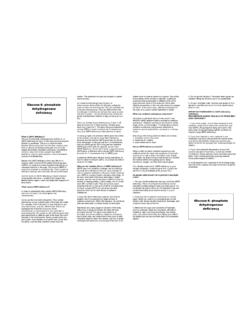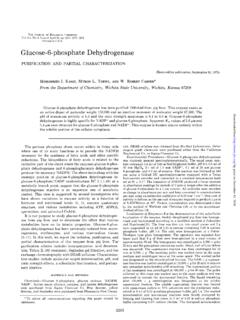Transcription of Comparison of detection of glucose-6- phosphate ...
1 Singapore Med J 2009; 50 (1) : 62O r i g i n a l A r t i c l eDepartment of Pathology, Faculty of Medicine, Universiti Kebangsaan Malaysia, Jalan Yaccob Latif, Kuala Lumpur 50600, MalaysiaWong FL, BSc Research OfficerAinoon O, MedScProfessor of HaematologyDepartment of PaediatricsBoo NY, FRCP Professor of NeonatologyWang MK, MMedRegistrarCorrespondence to: Prof Nem-Yun BooTel: (60) 6 767 7798 Fax: (60) 6 767 7709 Email: Comparison of detection of glucose -6- phosphate dehydrogenase deficiency using fluorescent spot test, enzyme assay and molecular method for prediction of severe neonatal hyperbilirubinaemiaWong F L, Boo N Y, Ainoon O, Wang M KABSTRACTI ntroduction: This study aimed to compare the detection rates of glucose - 6 - phosphate dehydrogenase (G6PD) deficiency in neonates by fluorescent spot test (FST), enzyme assay and molecular methods, and to identify which method was a significant predictor of severe hyperbilirubinaemia.
2 Methods: 74 term infants of Chinese descent admit ted with severe hyperbilirubinaemia (total serum bilirubin equal or greater than 300 micromol/L) and 125 healthy term infants born in the hospital without severe hyperbilirubinaemia were recruited into the study. Specimens of blood were collected from each infant for FST, G6PD enzyme assay and TaqMan minor groove binder single nucleotide polymorphism genotyping assay. Results: 26 ( percent) infants were diagnosed to have G6PD def iciency by FST. They had significantly lower median enzyme levels ( IU/g Hb, interquartile range [IQR] ) than those diagnosed to be normal ( IU/g Hb, IQR ) (p-value is less than ). Based on the enzyme assay, 39 ( percent) infants had G6PD deficiency at an enzyme cut-off level of less than IU/g Hb.
3 G6PD mutation was detected in 27 ( percent) infants. Logistic regression analysis showed t hat t he only signif icant predictors of severe hyperbilirubinaemia were G6PD deficiency based on a cut-off level of less than IU/g Hb (adjusted odds ratio [OR] , 95 percent confidence interval [CI] ; p-value is less than ) and exclusive breast-feeding (adjusted OR , 95 percent CI ; p-value is less than ). The gender and birth weight of infants, FST results, G6PD mutation and the actual G6PD enzyme levels were not significant predictors. Conclusion: A G6PD enzyme level of less than IU /g Hb is a significant predictor of severe hyperbilirubinaemia. Keywords: glucose -6- phosphate dehydrogenase , f l u o r e s c e n t s p o t t e s t , e n z y m e l e v e l , hyperbilirubinaemia , neonatal jaundiceSingapore Med J 2009; 50(1): 62-67 INTRODUCTIONS evere neonatal hyperbilirubinaemia with total serum bilirubin (TSB) 300 mol/L is a common problem in Malaysia, with a reported incidence of per 1,000 live births.
4 (1) glucose -6- phosphate dehydrogenase (G6PD) deficiency has been identified as one of the common causes of severe neonatal hyperbilirubinaemia in Malaysia. Despite this, in more than 40% of these infants, no underlying causes were identified.(1) Since its inception in the 1980s, the Malaysian G6PD newborn screening programme used the Beutler s modified fluorescent spot test (FST)(2) for the detection of G6PD deficiency. This test, being a qualitative one, detects only cases with severe G6PD deficiency when the enzyme levels are < 30% of the normal level.(3) In view of this limitation, measurement of the G6PD enzyme has been used in some countries as the screening method.(4,5) In recent years, with advances in molecular techniques, the detection of G6PD variants has become possible in many countries, although not yet as a routine screening method.
5 (6,7) Our research questions were how much more the Singapore Med J 2009; 50 (1) : 63detection rates of G6PD deficiency in infants with severe hyperbilirubinaemia could be improved by measurement of their G6PD enzyme levels and by molecular techniques, and which of these were better predictors of infants developing severe hyperbilirubinaemia. To answer this question, this study aimed to compare the detection rates of G6PD deficiency between FST and the measurement of actual enzyme levels, and between FST and molecular methods, and to identify the significant predictors associated with severe hyperbilirubinaemia in neonates with G6PD deficiency. METHODSThis observational study was carried out over a two-year period (from April 1, 2004 to March 30, 2006) in the neonatal intensive care unit and postnatal wards of the Hospital Universiti Kebangsaan Malaysia.
6 The inclusion criteria for severely hyperbilirubinaemic newborns were term infants (gestation between 37 and 42 completed weeks), with at least one parent of Chinese ethnicity, and who were admitted for severe unconjugated hyperbilirubinaemia (TSB > 250 mol/L during the first 48 hours of life, or TSB 300 mol/L thereafter). The exclusion criteria were infants with conjugated hyperbilirubinaemia > 15% of TSB levels, age 28 days of life or gestation < 36 weeks. On randomly-selected days, healthy term infants of Chinese ethnicity born in the hospital were recruited as controls. Parental consent was obtained for all cases prior to participation in the study. The institute s Research and Ethics Committees approved the study protocol. Upon admission, the following investigations were carried out on all severely hyperbilirubinaemic newborns: TSB level and fractionation, screening for G6PD deficiency using the World Health Organisation (WHO) qualitative FST,(8) quantitation of G6PD enzyme level, and single nucleotide polymorphism (SNP) analysis of G6PD gene for the seven common variants (G1376T, G1388A, A95G, C1024T, G871A, G487A, C563T) detected previously in the Malaysian Chinese population.
7 (9) For infants recruited as controls (without severe hyperbilirubinaemia), the blood tests mentioned above were carried out similarly on their cord blood specimens. Upon discharge and during the first seven days of life, these infants were monitored via phone calls by the investigators. They were also followed-up by their visiting community nurses according to standard protocol for newborn care in Malaysia. Infants with severe jaundice were referred to the hospital and treated accordingly. Infants confirmed to have severe hyperbilirubinaemia were removed from this non-severely hyperbiliriubinaemic group and included in the severely hyperbilirubinaemic group. Serum bilirubin levels of infants during the study were measured by the diazo method using the Cobas Integra system (Roche, Switzerland).
8 (10) Quantitation of G6PD enzyme level in erythrocytes was determined by the ultraviolet method(11) using Randox glucose -6- phosphate dehydrogenase kits (Randox Laboratories Ltd, United Kingdom) and a spectrophotometer (Hitachi model 717, Japan). G6PD deficiency was diagnosed when an enzyme level was < IU/g Hb, based on our previous study.(12) detection of G6PD variants was by real-time polymerase chain reaction (PCR) with TaqMan minor groove binder (MGB) SNP genotyping assay (Applied Biosystems, Foster City, CA), using ABI PRISM SDS 7000 (Applied Biosystems, Foster City, CA).(13) Oligonucleotide primers and probes for nucleotides G1376T, G1388A, A95G, C1024T, G871A, G487A and C563T were designed using Primer Express Software version (Applied Biosystems, Foster City, CA).
9 Genotyping assay was performed in a final reaction of 25 L, which contained L of 2 TaqMan Universal Master Mix, L of 40 TaqMan SNP genotyping assay mix (Applied Biosystems) and 15 g of genomic DNA in 12 L of distilled water. The amplification conditions were 2 mins at 50 C for AmpErase uracil-N-glycosylase activity and 10 mins at 95 C for Amplitaq Gold activation, followed by 40 cycles of 15 seconds at 95 C for denaturation and 1 min at 60 C for annealing and extension. The samples were run together with the non-template control in a 96-well plate. Allelic discrimination was performed on the post-PCR product. The fluorescence data of the post-PCR products were analysed directly using allelic discrimination software of the ABI Prism 7000 instruments and presented in an x-y scatter dot plot format.
10 Each sample was verified by examining the PCR curve generated to eliminate false-positive results due to aberrant light emission. For confirmation of the real-time PCR findings, all samples were subjected to sequencing using primers sequence for G6PD exon 2 13 described previously.(14) The Statistical Package for Social Science version (SPSS Inc, Chicago, IL, USA) was used for analysis of the data. Student s t-test (unpaired) was used for analysis of continuous variables with normal distribution between groups and the Mann-Whitney U test for variables with a skewed distribution. The chi-square test (or Fisher s exact test for expected values of < 5) was used for analysis of categorical variables. Using severity of hyperbilirubinaemia as the dependent variable, and the gender of infants, birth weight, exclusive breast-feeding, G6PD deficiency based on a cut-off level of < IU/g Hb, actual G6PD enzyme Singapore Med J 2009; 50 (1) : 64level, results of FST and presence of G6PD mutation as independent variables, forward logistic regression analysis was carried out to identify the significant predictors associated with the development of severe hyperbilriubinaemia.
